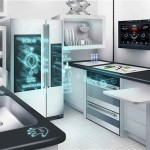 I’ve written previously about advances in smart technology for the home, and particularly its impact on elderly patients.
I’ve written previously about advances in smart technology for the home, and particularly its impact on elderly patients.
Smart Homes, developed by UT Arlington, come complete with a number of interesting technologies:
- Sensors underneath tiles on the floor that will allow researchers to measure and evaluate changes in walking gaits and weight that might suggest illness or injury;
- A special camera embedded in a bathroom mirror that will tell researchers about day-to-day heart rate, facial expression, and skin color. Changes in expression and skin color can reveal aspects of the overall health status as well as about oxygen content of the blood;
- Lift chair to help residents stand;
- Smart appliances such as an LG microwave, range and refrigerator;
- Connected exercise equipment, including a recumbent bike and interactive Kinect-based Tai Chi trainer;
- Other systems that will detect whether medication is being properly managed or if the resident is not sleeping well or staying in bed too long.
Predictive homes
An interesting aspect of this development is the predictive analytics deployed on the huge data generated from the home (and its inhabitants).
A good example of this in action comes from a Canadian company called ThinkEco Power. They track the data generated by any IoT connected appliances and build up a normative baseline of activity.
So they can gage how you’re using your appliances, your mobile phone and so on. When behavior flits outside of that norm, it can trigger a warning sign.
The technology features a sensor that’s attached to the house, with each sensor having a wi-fi range of 100m. It reads the data generated, and an algorithm then determines whether the appliances are on or off.
If it detects unusual behavior, it sends a notification to a relative or neighbour via text message. Indeed, if the situation is grave enough, it will even notify emergency services.
Ease of installation
The system is easily installed, with no physical attachments required for the service to detect each appliance. The hope is that it gives the elderly a bit of extra support in maintaining their independence.
“Detecting signs that might be early indicators of a heart attack, stroke or a preventable accident could ultimately help save thousands of lives,” the company say.
“ThinkEco Power’s appliance detection techniques were traditionally used for home energy audits, but have been re-engineered to non-invasively detect falls, locate the whereabouts of the individual and whether there have been changes in their daily household patterns.”
It’s an interesting product and a further sign that homes are becoming smarter.
I love this sort of stuff – super clever and so important as the population ages. We just need to be able to afford it all!